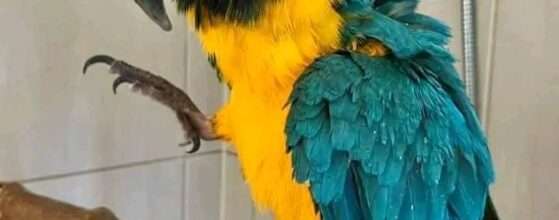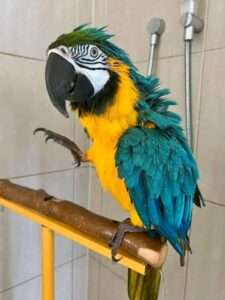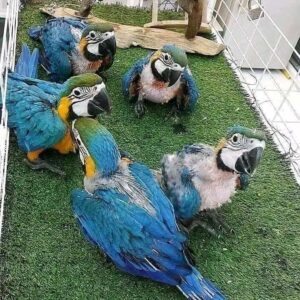
- by FPABS-Admin
- 0
- Posted on
Blue and Gold Macaw Markings
 Blue and gold macaws markings get their common name from their two most prominent feather colors. They typically have a green forehead, fading into a teal blue that covers the nape, back, tail, and wings. The chest and underside of the wings and belly are a bright golden yellow.
Blue and gold macaws markings get their common name from their two most prominent feather colors. They typically have a green forehead, fading into a teal blue that covers the nape, back, tail, and wings. The chest and underside of the wings and belly are a bright golden yellow.
Blue and Gold Macaw
These birds have large black beaks and a black patch of feathers just underneath its beak. White patches of skin adorned with rings of tiny black feathers surround their eyes and cover much of the face.
Blue and Gold Macaw Colors and Markings
Blue and gold macaws markings are monotypic, meaning there is only one bird that falls into the species. However, bird experts suggest that there are two variations or subspecies. These are the Bolivian blue and gold macaw, a larger bird with more of an actual blue coloring than the typical turquoise, and the blue-throated macaw, which has a teal blue throat instead of a black throat.
Caring for a Blue and Gold Macaw
Like most macaws, the blue and gold thrives on attention from its owner and will form a strong bond with its family members. Take time to socialize these birds properly and to provide them with adequate mental stimulation; otherwise, they might resort to screaming out of boredom.
Caring for a Blue Macaw
Like most macaws, the blue and gold thrives on attention from its owner and will form a strong bond with its family members. Take time to socialize these birds properly and to provide them with adequate mental stimulation; otherwise, they might resort to screaming out of boredom.
Common Health Problems
Macaws may be long-lived birds, but, like all parrots, they are prone to a viral infection called macaw wasting syndrome and overgrown beaks.1
Like other parrots, blue and golds may resort to self-mutilation by feather plucking if they feel neglected or bored.2
A well-balanced diet and adequate exercise are necessary to maintain pet bird health. This bird is prone to developing nutritional disorders like obesity, fatty liver disease, and fatty tumors.
Diet and Nutrition
In the wild, most macaws, including blue-and-gold macaws, eat a variety of seeds, plant material, fruits, and nuts.
Captive blue and gold macaws should get a varied diet consisting of as many different types of fresh fruits and vegetables as possible. The bird should also get a high-quality pelleted diet with some healthy seeds, such as flax, hemp, and chia. Avoid many nut treats; these are high in fat.
Exercise
Blue and gold macaws are active birds. They love to climb, swing, bounce, and chew. Owners should provide a minimum of 2 to 3 hours of playtime outside of the cage each day so that the bird can stretch and exercise its muscles.
These birds have powerful jaw muscles. Chewing and gnawing are necessary to keep their jaws healthy and in shape.1 Durable toys are a must, as the blue and gold’s beak is known to be destructive. Provide bird-safe chewable toys made of leather and have extras on hand as they get destroyed.
